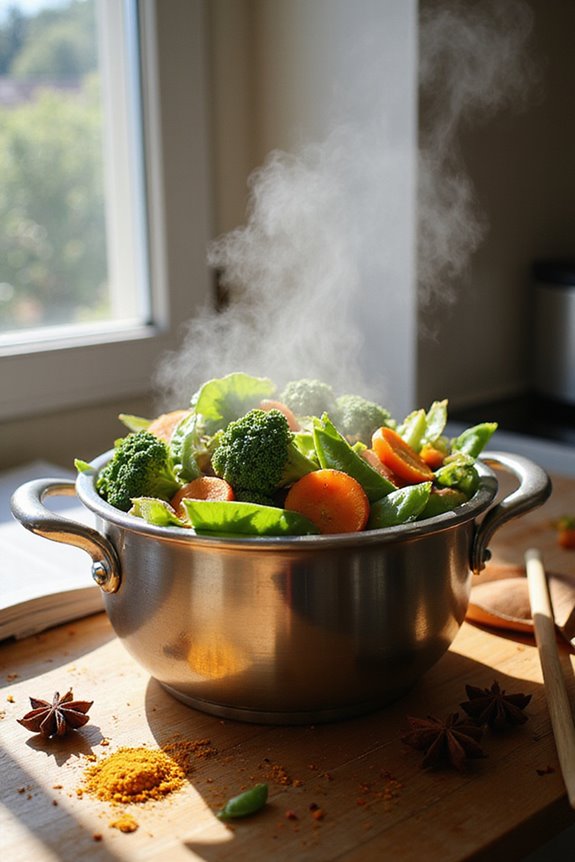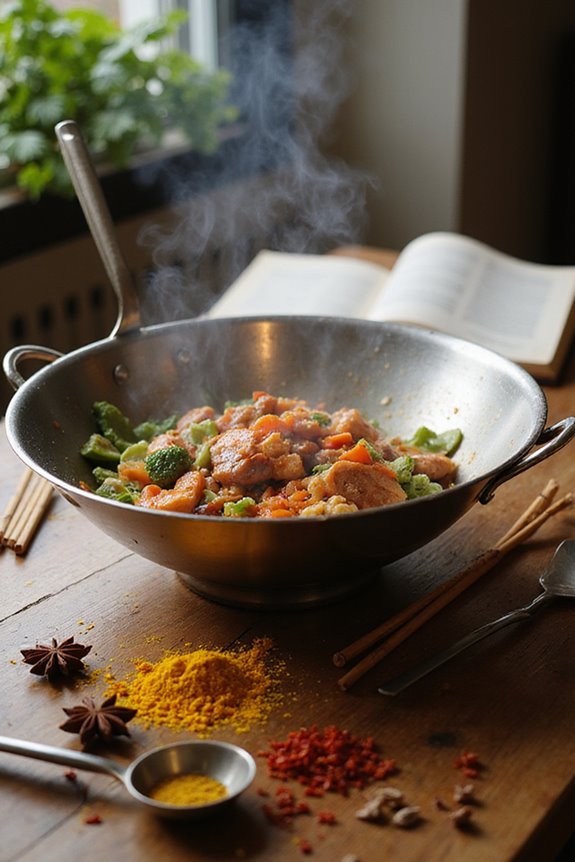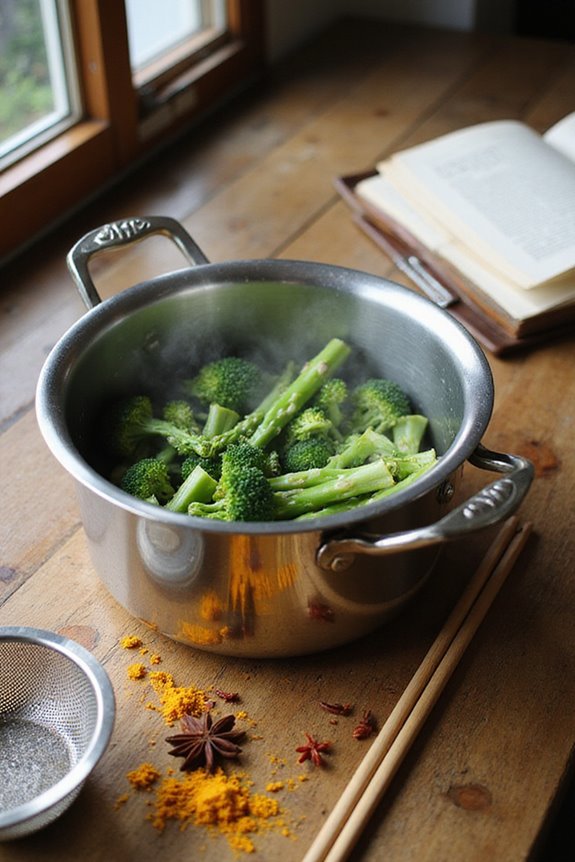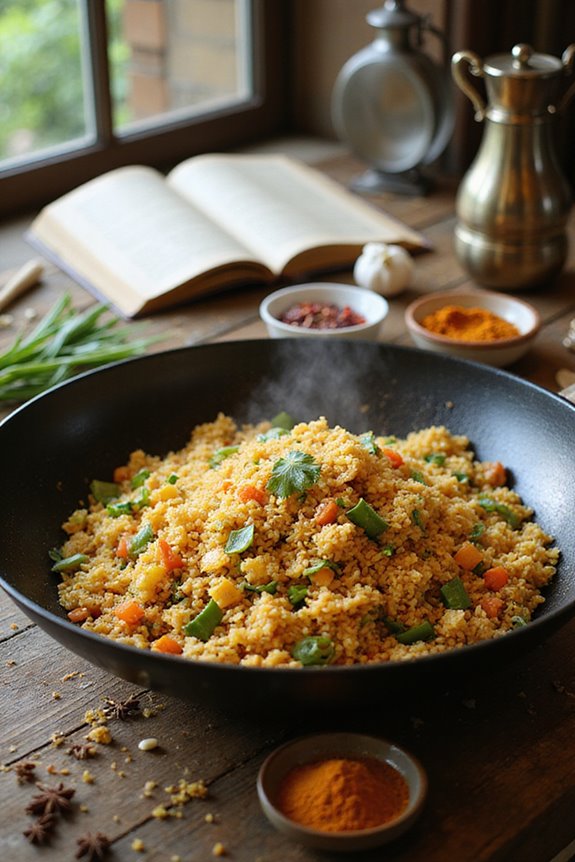Steaming veggies without overcooking is a delightful skill! First, we’ll rinse and chop our veggies into even sizes. Then, we can set up our steamer and use timers. Here’s the magic: for leafy greens like spinach, just 30 seconds does the trick, while crunchy carrots need 8-10 minutes. To keep them vibrant, check frequently and use a plate to keep them above boiling water. Stick around, and we’ll explore even more fun tips to elevate your veggie game!
Key Takeaways
- Use a steamer basket to prevent direct contact with boiling water, helping to reduce the cooking time.
- Layer heartier vegetables on the bottom of the steamer and delicate ones on top for even cooking.
- Set timers for 3-5 minutes and check for doneness frequently to avoid overcooking.
- Remove vegetables promptly once they are tender to preserve their texture and nutrients.
- Use proper seasoning and fresh ingredients to enhance flavor without relying on extended cooking times.
Preparing Your Vegetables for Steaming
When we’re getting ready to steam our vegetables, it’s a delightful journey that starts with preparation! First, let’s embrace some pre-steaming tips to guarantee every bite is magical. We’ll rinse our veggies under cold water—maybe even give those carrots a little scrub with a vegetable brush.
Next, we’ll chop them evenly so they cook just right, making sure to size harder veggies smaller than softer ones. Remember to keep everyone in the same shape party—sticks or cubes work wonders!
Don’t forget to remove any wilted leaves or cores before steaming. Finally, let’s dry our veggies gently to remove excess water. With these vegetable preparation steps, we’re ready for the flavorful steaming adventure ahead! Additionally, using a steamer basket with heat-resistant handles can enhance safety while lifting your cooked veggies.
Choosing the Right Equipment
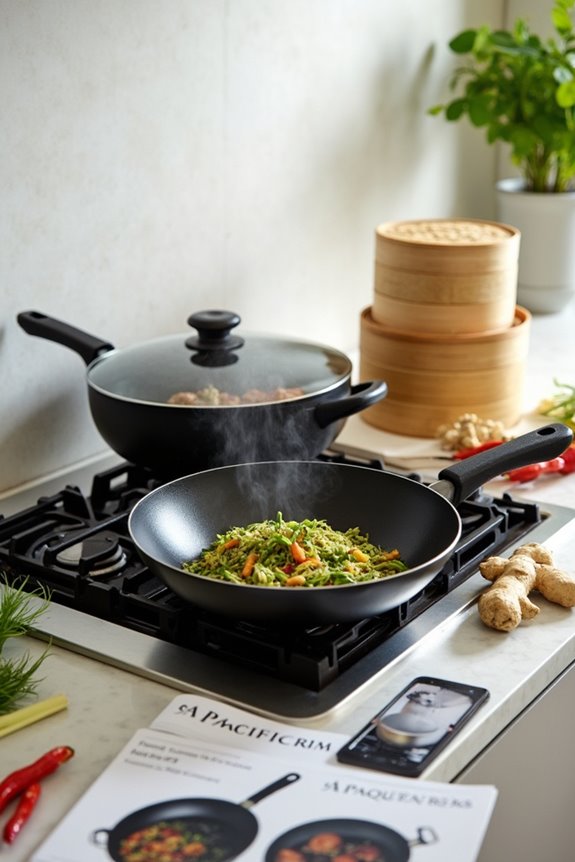
Choosing the right equipment for steaming vegetables can make all the difference, and thankfully there are several fantastic options at our disposal! Here’s a quick overview to help us choose:
- Electric steamers offer digital timers and multiple tiers, perfect for batch cooking.
- Metal baskets are sturdy and easy to clean—great for fitting in pots.
- Silicone baskets are versatile and foldable, making storage a breeze.
- For a traditional touch, bamboo steamers are charming but may require more care.
- All-in-one sets allow us to steam and cook pasta simultaneously—just watch those water levels!
Additionally, consider the benefits of tri-ply construction, which provides even heat distribution for perfect cooking results. Let’s also remember material durability and cleaning maintenance; stainless steel or dishwasher-safe options can save us time while delivering delightful dishes! Happy steaming!
Setting Up Your Steaming Station

Setting up our steaming station is like creating a magical cooking adventure! First, let’s gather our gear: a pot or wok with a lid, a heatproof dish, and a trusty metal steam rack. Keeping an eye on water levels is key for steam preservation—make sure it’s at least 2 inches high but never touching the bottom of the steamer. We’ll prepare our vegetables by cutting them into uniform sizes, ensuring their delightful steam journey is even. Remember, no overcrowding please! Finally, let’s maintain our steamer with care—using oven mitts and monitoring steam carefully keeps everyone safe. Additionally, using a high-quality stainless steel steamer basket can enhance your cooking efficiency by retaining nutrients and flavors in the food. With these simple steps, we’re all set to steam up something special! Happy cooking, friends!
Timing Guidelines for Different Vegetables
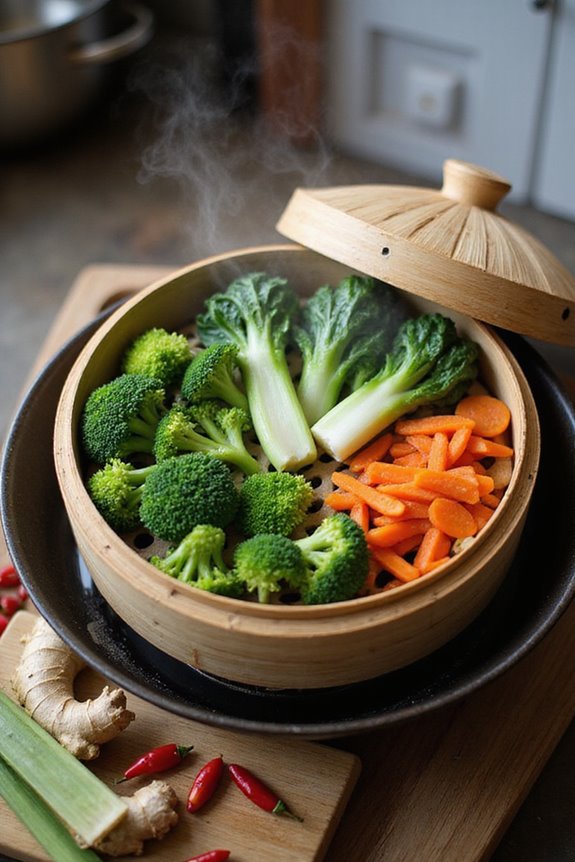
Timing vegetables for steaming can feel like a delightful treasure hunt, where precision leads us to the perfect taste! Here’s a quick guide to help us all navigate the steaming journey:
- Leafy Vegetables: Spinach steams in just 30 seconds! Asparagus needs 6 to 8 minutes, while broccoli florets take 4 to 6.
- Root Vegetables: Carrots will need about 8 to 10 minutes, and baby potatoes should steam for 10 to 12 minutes.
- Cruciferous Vegetables: Cauliflower represents an ideal 5 to 7 minutes of steaming!
- Specialized Vegetables: Artichokes are a bit longer at 20 to 30 minutes, while corn on the cob needs just 8 to 10 minutes.
- Frozen Vegetables: They typically take only 3 to 5 minutes.
Let’s remember, timing is our secret ingredient for delicious results! Investing in quality tools enhances our ability to steam vegetables perfectly.
Techniques to Avoid Overcooking
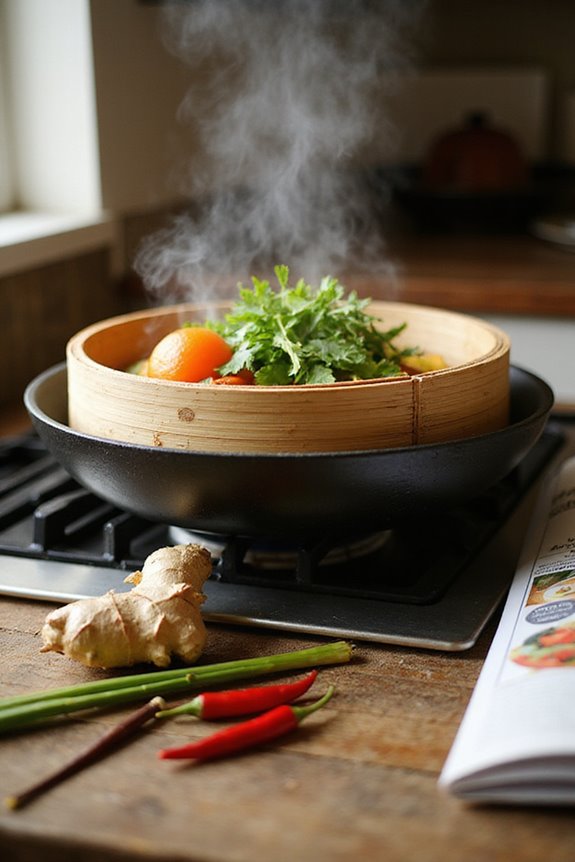
After we’ve gotten the timing down for our favorite veggies, let’s focus on keeping them perfectly cooked and delicious! Here are some awesome steaming techniques to avoid overcooking and maintain delightful vegetable textures:
- Use the Plate and Foil Method: Elevating veggies above simmering water keeps them evenly cooked.
- Layer Wisely: Put heartier vegetables on the bottom and delicate ones on top—think of it as a veggie holiday pyramid!
- Check Often: Set timers for 3–5 minutes and peek for doneness; we don’t want sad, mushy snacks.
- Remove Promptly: As soon as veggies are tender, take ‘em off the heat—it’s like a magical culinary dance! Additionally, using ergonomic utensils can help you easily maneuver and serve your perfectly steamed vegetables.
With these tips, we’ll serve up perfectly steamed veggies every time! Happy cooking!
Retaining Nutritional Value and Flavor
When we think of preparing our veggies, it’s hard not to get excited about how to keep their delightful flavors and nutritional benefits intact. Steaming is magical for nutrient retention, especially for vitamins like C and folate. Here’s why we love it:
- Preservation: It keeps glucosinolates—a cancer-fighting compound—intact, even enhancing them in some veggies!
- Flavor Boost: Steaming maintains natural flavors and moisture better than boiling or frying, making every bite a taste sensation.
To love our veggies and keep them vibrant, remember to steam them for just the right time. Avoid excessive heat and water, and skip those alkaline additives! Get those flavors popping while enjoying all the health benefits, and we’ll be on our way to veggie paradise! Additionally, using non-stick properties can help prevent vegetables from adhering to the steamer, ensuring they maintain their perfect texture and presentation.
Alternative Methods of Steaming
Steaming our favorite veggies can be a fun adventure, especially when we explore alternative methods! Let’s channel our creativity for some delightful steaming. We can use everyday kitchen items like metal strainers, heat-safe plates, or even aluminum foil to create a magical steamer. Just remember to keep them above simmering water—about 2 inches deep to maintain that gentle steam!
To infuse flavors, let’s place sliced onions or lemon beneath our vegetables for a zesty twist. Don’t forget, using lids or inverted plates helps trap steam in, ensuring everything cooks evenly. As we begin our cooking journey, let’s savor these unique techniques and enjoy the flavorful results together! Happy steaming, friends!
Tips for Staggering Cooking Times
To guarantee our vegetables steam perfectly and maintain their delightful crunch, we need to plan for different cooking times. Here’s a little magic of staggering vegetables to perfect our cooking order:
- Start with denser veggies: Carrots and potatoes take the longest, so let them steam for about 8-12 minutes first.
- Next up, medium-density stars: Broccoli and cauliflower join the party around the 6-10 minute mark.
- Finally, invite the delicate greens: Asparagus and leafy greens only need about 3-5 minutes, so toss them in last.
Enhancing Flavor After Steaming
After we’ve mastered the art of timing our steamed vegetables, it’s time to unfasten the door to flavor magic! We can take our vibrant veggies to the next level with delightful flavor infusions and herb enhancements. Here’s how:
- Steaming Secrets: Add lemon juice or fresh herbs like basil into the steaming water for a tasty aroma.
- Post-Pepping: A drizzle of rich olive oil or a sprinkle of chopped parsley can elevate everything.
- Umami Boost: Try a splash of soy sauce or sprinkle some nutritional yeast to introduce savory layers.
- Zesty Finish: Top it off with fresh citrus zest or a dash of vinegar for a delightful zing!
Let’s make our plate a feast of flavor together!
Frequently Asked Questions
Can I Steam Vegetables Without a Lid?
Absolutely, we can steam vegetables without a lid! Let’s explore various steaming techniques and lid alternatives, like using a damp towel or plastic wrap, ensuring our veggies cook perfectly without losing flavor or texture.
What Vegetables Shouldn’T Be Steamed Together?
Like a well-composed symphony, our choice of vegetable compatibility matters when steaming. We shouldn’t mix delicate and dense vegetables; it’s best to apply thoughtful steaming techniques, ensuring every bite becomes a harmonious celebration of flavors.
How Do I Know When Vegetables Are Done?
When we’re cooking vegetables, we should pay attention to cooking times and our texture preferences. A simple knife test can tell us when they’re done—just aim for that perfect balance between tender and crisp!
Can I Re-Steam Overcooked Vegetables?
Absolutely, we can try re-steaming vegetables for overcooked vegetable recovery! It’s a gentle way to enhance texture and flavor, allowing us to create delicious dishes while making the most of our culinary mishaps together.
Is It Okay to Steam Frozen Vegetables?
Is it okay to steam frozen veggies? Oh, absolutely! We love ’em—frozen vegetable benefits abound! Just remember, varying steaming time lets us enjoy tasty bites without surrendering texture; let’s savor those vibrant flavors together, shall we?

